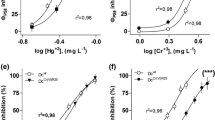Abstract
Mercury chloride toxicity was investigated in two strains of Chlorella and in a strain of Scenedesmus isolated from polluted areas in Tuscany (Italy). No Hg resistance was found in the autotrophic microorganisms isolated, but Scenedesmus sp. strain AR-2489, isolated from the Arno river, was able to grow at concentrations of up to 5 mg ml1 of Hg. This concentration was twice that which inhibited growth of the two Chlorella strains and Scenedesmus acutus 8M, the reference strain from a culture collection. Photosynthesizing cells of Scenedesmus sp. AR-2489 showed reduced Hg uptake, with the highest percentage of Hg removal from the medium. Loss of Hg was not due to Hg(0) volatilization, as shown by a comparison test with the broad-spectrum Hg-resistant Pseudomonas putida FB1. The metabolic differences between Scenedesmus sp. strain AR-2489 and Siacatus strain 8M were: (1) higher growth rate (doubling time of 6.0h versus 10.6 h); (2) higher O2 production rate (maximum 2 mmol h mg dry weight); and (3) higher intracellular pH during growth. The latter was imaged with a green fluorescence molecular probe (BCEFC–AM) and observed by scanning confocal laser microscopy (SCLM). The distribution of red-autofluorescence chlorophyll-a showed that strain AR-2489 had a rougher and hence more extended specific chloroplast surface than strain 8M. Hg tolerance in strain AR-2489 was related to the rapid increase in dissolved O in the medium and in intracellular pH; this caused a loss of soluble mercury transformed to insoluble mercury hydroxide, which is thermodynamically more stable at alkaline pH in highly oxygenated systems.
Similar content being viewed by others
References
Andersson A. 1979 Mercury in soil. In: Nriagu JO, ed. The Biogeochemistry of Mercury in the Environment,The Netherlands: Elsevier/North Holland Biomedical Press; 79–106.
Baldi F. 1997 Microbial transformation of mercury species and their importance in the biogeochemical cycle of Hg. In: Sigel H, Sigel A, eds. Mercury and its Effects on Environment and Biology,Vol 34. New York: Marcell Dekker, Inc.; 213–257.
Baldi F, Olson GJ, Brinckman FE. 1985 Mercury transformations by heterotrophic bacteria isolated from cinnabar and other metal sulfide deposits in Italy. Geomicrobiol J 5, 1–16.
Baldi F, Coratza G, Manganelli R, Pozzi G. 1988 A strain of Pseudomonas putidaisolated from a cinnabar mine with a plasmid-determined broad-spectrum resistance to mercury. Microbios 54, 7–13.
Baldi F, Filippelli M, Olson GJ. 1989 Biotransformation of mercury by bacteria isolated from a river collecting cinnabar mine waters. Microb Ecol 17, 263–274.
Baldi F, Boudou A, Ribeyre F. 1992 Response of a freshwater bacterial community to mercury contamination (HgCl2 and CH3HgCl) in a controlled system. Arch Environ Contam Toxicol 22, 439–444.
Baldi F, Bianco MA, Pepi M. 1995 Mercury, arsenic and boron resistant bacteria isolated from the phyllosphere as positive bioindicators of airborne pollution near geothermal plants. Sci Total Environ 164, 99–107.
Ben-Bassat D, Mayer AM. 1975 Volatilization of mercury by algae. Physiol Pl 33, 128–132.
Ben-Bassat D, Mayer AM. 1977 Reduction of mercury chloride by Chlorella: evidence for a reducing factor. Physiol Pl 40, 157–162.
Bruland KW, Donat JR, Hutchins DA. 1991 Interactive influences of bioactive trace metals on biological production in oceanic waters. Limnol Oceanogr 36, 1555–1557.
Brunker RL, Bott TL. 1974 Reduction of mercury to the elemental state by a yeast. Appl Environ Microbiol 27, 870–873.
Collins YE, Stotzky G. 1989 Factors affecting the toxicity of heavy metals to microbes. In: Beveridge TJ, Doyle RJ, eds. Metal Ions and Bacteria. New York: J Wiley & Sons; 31–90.
Crist RH, Oberholser K, Shank W, Nguyen M. 1981 Nature of bonding between metallic ions and algal cell walls. Envir Sci Technol 15, 1212–1217.
Drbal K, Vèber K, Zahradnìk J. 1985 Toxicity and accumulation of copper and cadmium in the alga Scenedesmus obliquusLH. Bull Environ Contam Toxicol 34, 904–908.
Efiok BJS, Webster DA. 1990 Respiratory-driven Na+ electrical potential in the bacterium Vitreoscilla. Biochemistry 29, 4734–4739.
Fiore MF, Trevors JT. 1994 Cell composition and metal tolerance in cyanobacteria. BioMetals 7, 83–103.
Foster TJ. 1987 The genetics and biochemistry of mercury resistance. Crit Rev Microbiol 15, 117–140.
Hahne HCH, Kroontje W. 1973 Significance of pH and chloride concentration on behavior of heavy metal pollutants mercury ion, cadmium, ion zinc ion, and lead ion. J Envir Qual 2, 444–450.
Haugland RP. 1992 Handbook of fluorescent probes and research chemicals. In: Larison KD, ed. Molecular Probes,Inc. Eugene, OR, USA, 390 pp.
Mason RP, Morel FMN, Hemond HF. 1995a The role of microorganisms in elemental mercury formation in natural waters. Water Air Soil Pollut 80, 775–787.
Mason RP, Rolfhus KR, Fitzgerald WF. 1995b Methylated and elemental mercury cycling in surface and deep ocean waters of the North Atlantic. Water Air Soil Pollut 80, 665–667.
Nelson JD, Blair WR, Brinckman FE, Colwell RR, Iverson WI. 1973 Biodegradation of phenylmercury acetate by mercury-resistant bacteria. Appl Microbiol 26, 321–326.
Robinson JB, Tuovinen OH. 1984 Mechanisms of microbial resistance and detoxification of mercury and organomercury compounds: physiological, biochemical, and genetic analyses. Microbiol Rev 48, 95–124.
Silver S, Walderhaug M. 1992 Gene regulation of plasmidand chromosome-determined inorganic ion transport bacteria. Microbiol Rev 56, 195–228.
Summer AO. 1986 Organization, expression, and evolution of genes for mercury resistance. Ann Rev Microbiol 40, 607–634.
Tsujimoto K, Semadeni M, Hufletjt M, Packer L. 1988 Intracelluar pH of Halobacteria can be determined by the fluorescent dye 2′,7′-bis(carboxyethyl)-5(6) carboxyfluorescein. Biochem Biophys Res Comm 155, 123–129.
Yannai S, Berdicevsky I, Duek L. 1991 Transformations of inorganic mercury by Candida albicans and Saccharomyces cerevisiae . Appl Environ Microbiol 57, 245–247.
Author information
Authors and Affiliations
Corresponding author
Rights and permissions
About this article
Cite this article
Capolino, E., Tredici, M., Pepi, M. et al. Tolerance to mercury chloride in Scenedesmus strains. Biometals 10, 85–94 (1997). https://doi.org/10.1023/A:1018375005791
Issue Date:
DOI: https://doi.org/10.1023/A:1018375005791




